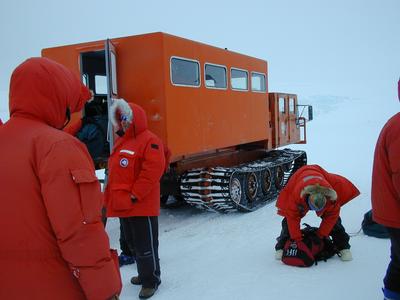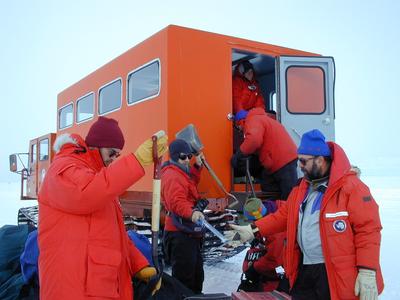
|
7 November, 2001Immediately upon arising this morning, we began to load our gear on sleds and take down camp in order to have all gear on the "banana" sleds by the 9:00 a.m. pickup. Our two instructors, Thai and Ty, have been wonderful and patient teachers. The wind was still blowing hard as we took down the tents. I slept in a Scott tent with two other people. Juliette was from France, and Liz was finishing her doctorate dissertation on photosynthesis. Most of the people in the group will be doing science research in field camps in the Dry Valleys or near McMurdo, West Antarctica, or the South Pole. The greatest surprise was sharing this snow school experience with another TEA, (Teacher Experiencing Antarctica and the Arctic program) Jen Curtis. We had become friends when we attended the TEA orientation at CRREL (The Cold Region Research and Engineering Laboratory). Together, we experienced the inside of the "snow dome". It was fun to build this snow Quinsi and to climb inside, but we both chose to sleep in tents. It was so cold and windy, neither of us wanted to chance getting sick before we headed to our field camps. Jen will be doing seismic research as she travels around the Trans Antarctic Mountains by helicopter. Her TEA web page may be found at the TEA site: ../. Click on "Meet the Teachers". After we loaded the gear on the Nodwell, we walked back to the instructors' Jamesway hut to eat a quick breakfast. The safety lessons were continued as we learned how to operate and transmit radio signals. We used a VHF (very high frequency) radio to contact McMurdo, or someone in camp that was a short distance away from us. This radio signal bounces from one unit to the next. We also set up a HF (Hi Frequency) "MASH-like" radio, similar to what is seen in war movies, so that we could try to call the South Pole as part of our operation's practice. Juliette also tried to call the French field camp. The weather didn't cooperate, so the only communication contact was with McMurdo. The interference also kept several field camps from making contact with McMurdo. Again, Antarctica is in control. The high frequency radio works by bouncing off the Ionosphere, which allows the capability of sending messages to any place on the planet. The next part of our training involved working through two different scenarios. The first was a "pretend" breakdown of the Nodwell vehicle. We quickly set up camp without speaking. In high winds, talking would be out of the question because the howling wind would prevent effective vocal communication. We set up a two-man tent, built a snow wall to shelter the tent from high winds, and lit a stove. We used the emergency gear provided in the Nodwell. We had smaller handsaws, which made it harder to cut through the snow. We also had a broken shovel to lift the snow blocks for our snow wall. The people in our group who put up the tent found that they didn't have enough stakes to secure the tent. One of the parcticipants, who is a shuttle bus driver in Antarctica this season, used his small flashlight as a "deadman's anchor". Shovels and picks were also used to stake the tent into the ground. Three stove kits had to be tried before one worked. The first one didn't have enough fuel, the second one didn't have a cleaning kit, nor the tools needed to operate the stove. As soon as the stove was lit, our time was called. I believe this emergency site was set up in about 20 minutes. We also experienced a "white-out" condition by putting white buckets on our heads to simulate not being able to see anything around us. During this condition, the blowing snow would cause poor visibility. We tied one end of the rope to a bed in the Jamesway, and the other end to the lead person. In this scenario, we were looking for someone who had gone to the outhouse and couldn't get back. We spaced ourselves about a meter apart on the rope and began walking in an arc until we found the outhouse. After checking inside, we continued the hunt until we literally ran into Thai. He pretended to be in a hypothermic state. We carried him back to the shelter. Before ending our training, we went back to the Crary Lab for helicopter safety training. When I checked in for news on my upcoming departure to my field camp, I sadly learned that one of the TEAs, Jan French, who was scheduled to travel by tractor and sled to collect ice cores, had fallen and broken her ankle. She was already being flown out by the time I got back from my training. I met two of her scientists during my stay in Christchurch, so I know she must be devastated. I briefly saw her before I left for my snow school training. One of our main focuses while in Antarctica is to constantly think safety because the ice and the extreme cold could make conditions treacherous. Safety is "first-most" in our thoughts, but even so, accidents can happen when least expected. Heartfelt thoughts are with Jan as she heads for surgery back in Christchurch.
Contact the TEA in the field at . If you cannot connect through your browser, copy the TEA's e-mail address in the "To:" line of your favorite e-mail package. |







